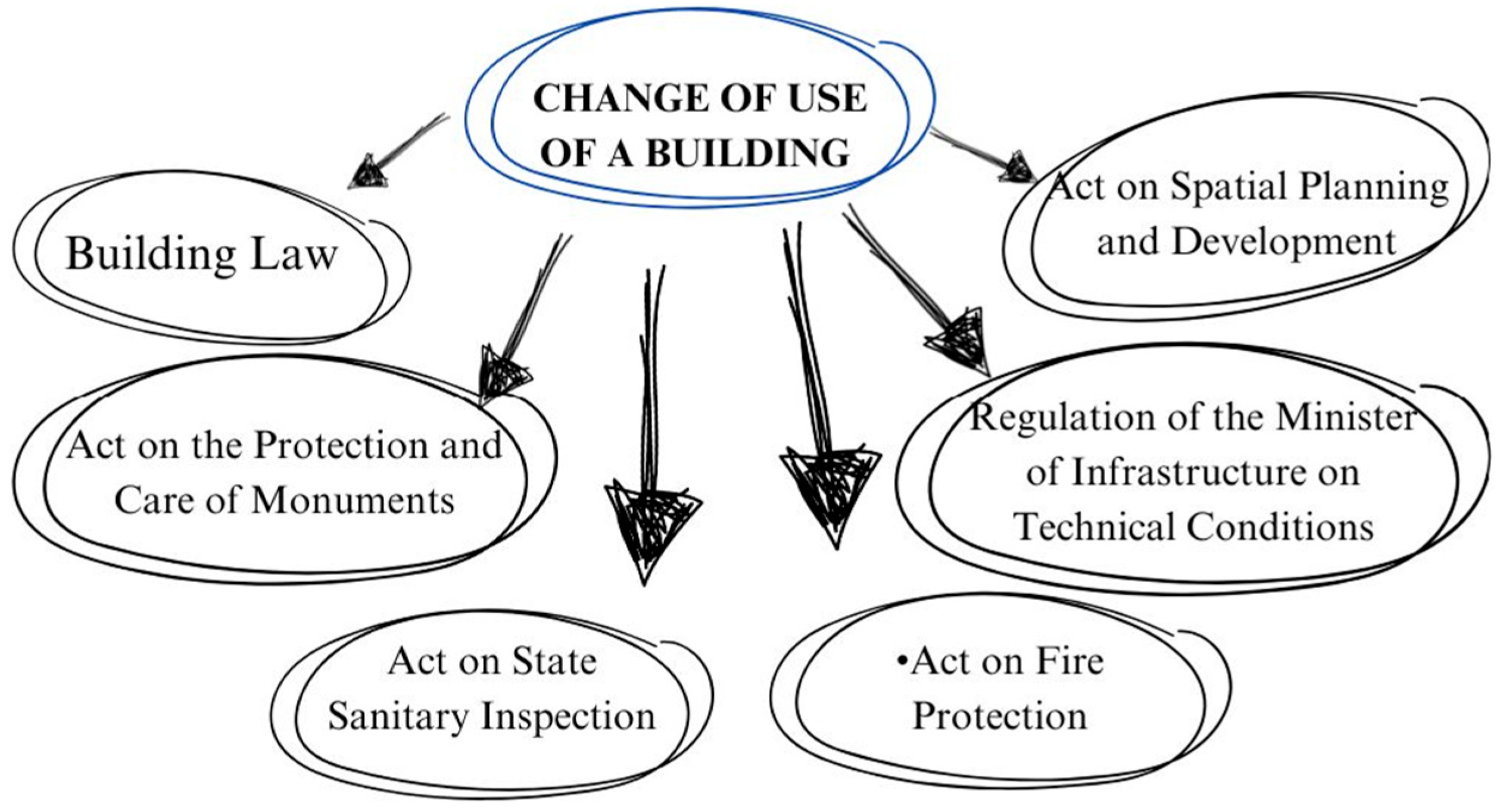Revitalization of Zabłocie in Kraków: Innovation Cluster as One of the Elements of District Development
Abstract
1. Introduction
2. The Urban and Historical Context of the Zabłocie District
3. Innovation Cluster as One of the Key Investments in the Revitalization Process of Zabłocie District
3.1. Methodology
3.2. Genesis of the Idea of Creating a Cluster
3.3. Legal Aspects of Implementation of Investments Related to Change of Use
3.4. Implementation of the Investment Under the Design and Build System
3.5. Use of the CDE Cloud Platform for Efficient Management of the Investment Process
4. Difficult Beginnings of Using the Cluster
5. Summary
Author Contributions
Funding
Institutional Review Board Statement
Informed Consent Statement
Data Availability Statement
Conflicts of Interest
References
- Sobotka, A.; Linczowski, K.; Radziejowska, A. Substitution of Building Components in Historic Buildings. Sustainability 2021, 13, 9211. [Google Scholar] [CrossRef]
- Cirami, S.; Evola, G.; Gagliano, A.; Margani, G. Thermal and Economic Analysis of Renovation Strategies for a Historic Building in Mediterranean Area. Buildings 2017, 7, 60. [Google Scholar] [CrossRef]
- Li, Y.; Zhang, S.; Yang, J.; Ye, C.; Chen, W. Sustainable Development of Industrial Renovation: Renovation Paths of Village-Level Industrial Parks in Pearl River Delta. Sustainability 2023, 15, 9905. [Google Scholar] [CrossRef]
- Kuzior, A.; Grebski, W.; Kwilinski, A.; Krawczyk, D.; Grebski, M.E. Revitalization of Post-Industrial Facilities in Economic and Socio-Cultural Perspectives—A Comparative Study between Poland and the USA. Sustainability 2022, 14, 11011. [Google Scholar] [CrossRef]
- Zwiech, D. Development perspectives and problems accompanying the regeneration of Zabłocie (Kraków) over the years. Urban Dev. Issues 2018, 55, 44–56. [Google Scholar] [CrossRef][Green Version]
- Marzena, P. Revitalization postindustrial area of Zabłocie. Zarządzanie Publiczne 2013, 1, 1203–1213. [Google Scholar] [CrossRef]
- Kowalski, A.M. Kooperacja w ramach klastrów jako czynnik zwiększenia innowacyjności i konkurencyjności regionów. Gospod. Nar. 2010, 5–6, 1–17. [Google Scholar]
- Wyrzykowska, B. Cooperation between science and agricultural-food industry on the example of the Innovation Cluster in Agricultural Business. Probl. Zarz. 2015, 13, 166–181. [Google Scholar] [CrossRef]
- Szczupska, M.; Grzelak, P.; Jarzębowski, S. Klaster jako potencjał na przyszłość—Studium przypadku. Zesz. Nauk. SGGW-Ekon. I Organ. Gospod. Żywnościowej 2012, 100, 95–106. [Google Scholar] [CrossRef]
- Mostostal Warszawa. Project Documentation. Zabłocie 20.22 Socio-Economic Innovation Cluster. Available online: https://www.mostostal.waw.pl/en/projects/general/socio-economic-innovation-cluster-in-krakow (accessed on 8 September 2024).
- Zabłocie 20.22 Socio-Economic Innovation Cluster—Magical Krakow. Available online: https://www.krakow.pl/aktualnosci/262093,26,komunikat,klaster_innowacji_spoleczno-gospodarczych_Zabłocie_20_22.html (accessed on 8 September 2024).
- Zakończyliśmy Budowę Klastra Innowacji Zabłocie. Available online: https://www.mostostal.waw.pl/firma/aktualnosci/zakonczylismy-budowe-klastra-innowacji-zablocie (accessed on 8 September 2024).
- Flyvbjerg, B. Five Misunderstandings About Case-Study Research. Qual. Inq. 2006, 12, 219–245. [Google Scholar] [CrossRef]
- Drelich-Skulska, B.; Jankowiak, A.; Mazurek, S. Klastry Jako Nośnik Innowacyjności Przedsiębiorstw i Regionów Czy Doświadczenia Azjatyckie Można Wykorzystać w Warunkach Gospodarki Polskiej? Wydawnictwo Uniwersytetu Ekonomicznego We Wrocławiu, 2014. Available online: https://24naukowa.com.pl/klastry-jako-nosnik-innowacyjnosci-przedsiebiorstw-i-regionow-czy-doswiadczenia-azjatyckie-mozna-wykorzystac-w-warunkach-gospodarki-polskiej,id4659.html (accessed on 24 April 2025).
- Ferras-Hernandez, X.; Nylund, P.A. Clusters as Innovation Engines: The Accelerating Strengths of Proximity. Eur. Manag. Rev. 2019, 16, 37–53. [Google Scholar] [CrossRef]
- Vladimir, V.; Mazur, K.B.; Sergey, S.D.; Maxsim, A.B.; Evgeny, T. Innovation Clusters: Advantages and Disadvantages. Int. J. Econ. Financ. Issues 2016, 6, 270–274. [Google Scholar]
- Christopoulos, G.; Wintjes, R. Identifying Clusters as Local Innovation Systems. J. Knowl. Econ. 2024, 15, 9784–9823. [Google Scholar] [CrossRef]
- Bărbulescu, O.; Nicolau, C.; Munteanu, D. Within the Entrepreneurship Ecosystem: Is Innovation Clusters’ Strategic Approach Boosting Businesses’ Sustainable Development? Sustainability 2021, 13, 11762. [Google Scholar] [CrossRef]
- McPhillips, M. Innovation by proxy—Clusters as ecosystems facilitating open innovation. J. Entrep. Manag. Innov. 2020, 16, 101–128. [Google Scholar] [CrossRef]
- Change of Use of a Building. Available online: https://www.biznes.gov.pl/pl/portal/ou555 (accessed on 3 September 2024).
- Act of 7 July 1994 Construction Law. Available online: https://isap.sejm.gov.pl/isap.nsf/DocDetails.xsp?id=WDU20250000418 (accessed on 22 January 2025).
- Notice of the Minister of Development and Technology of 15 April 2022 on the Announcement of the Uniform Text of the Reg-ulation of the Minister of Infrastructure on the Technical Conditions to be Met by Buildings and Their Location. Available online: https://1040.konkurs.sarp.pl (accessed on 19 August 2024).
- Act on Spatial Planning and Development. Available online: https://bakertilly.pl/legal/en/amendments-to-the-act-on-spatial-planning-and-development-extension-of-the-deadline-for-preparing-general-plans/ (accessed on 19 August 2024).
- Act on State Sanitary Inspection. Available online: www.ris.bka.gv.at (accessed on 19 August 2024).
- Act on the Protection and Care of Monuments. Available online: https://www.kulturgutschutz-deutschland.de/SharedDocs/ExterneLinks/EN/Gesetze_en/DSchG_Laender/HE_DSchG.pdf?__blob=publicationFile (accessed on 19 August 2024).
- Act on Fire Protection. Available online: https://oso.edu.pl/en/knowledge-base/fire-protection-regulations/ (accessed on 19 August 2024).
- Li, C.; Zhai, F.; Schipaanboord, B.W.K.; Breedveld, S.; Radl, J.; Kaiser, J. Benefits of Implementation of Common Data Environment (CDE) into Construction Projects. In IOP Conference Series: Materials Science and Engineering; IOP Publishing: Bristol, UK, 2019; Volume 471, p. 022021. [Google Scholar]
- BIM to Field: The True Strength of BIM Applied Directly On-Site!—BibLus. Available online: https://biblus.accasoftware.com/en/bim-to-field-the-true-strength-of-bim-applied-directly-on-site/ (accessed on 24 April 2025).
- Seyis, S.; Özkan, S. Analyzing the added value of common data environments for organizational and project performance of BIM-based projects. Itcon 2024, 29, 247–263. [Google Scholar] [CrossRef]
- Łataś, R.; Walasek, D. BIM w CDE. Mater. Bud. 2019, 1, 47–49. [Google Scholar] [CrossRef]
- Kasznia, D.; Magiera, J.; Wierzowiecki, P. BIM w Praktyce, Księgarnia PWN. Available online: https://ksiegarnia.pwn.pl/BIM-w-praktyce,820358255,p.html (accessed on 6 March 2024).
- Bałazy, A. CDE—Klucz Do Efektywnej Współpracy—BIMagination. Available online: https://bimagination.pl/cde-klucz-do-efektywnej-wspolpracy/?utm_source=chatgpt.com (accessed on 16 March 2024).
- Pubanz, K.; Kaczorek, K.; Prothenko, K. The Role of CDE in BIM Processes—Civil Engineer. Inżynier Budownictwa, 2022. Available online: https://inzynierbudownictwa.pl/rola-cde-w-procesach-bim-owych/ (accessed on 11 September 2024).
- Abdullah, O.H.; Hatem, W.A. The use of BIM to propose alternative construction methods to reduce the cost of energy for the historic archeological building in Iraq. Arch. Civ. Eng. 2023, 69, 535–549. [Google Scholar] [CrossRef]
- Borkowski, A.S.; Brożyna, J.; Litwin, J.; Rączka, W.; Szporanowicz, A. USE OF THE CDE ENVIRONMENT IN TEAM COLLABORATION IN BIM. Inform. Autom. Pomiary W Gospod. I Ochr. Srodowiska 2023, 13, 93–98. [Google Scholar] [CrossRef]
- Sinenko, S.; Hanitsch, P.; Aliev, S.; Volovik, M. The implementation of BIM in construction projects. In E3S Web of Conferences; EDP Sciences: Julius, France, 2020; p. 08002. [Google Scholar] [CrossRef]
- BIM on Construction Site. Available online: https://bzg.pl/poradnik/artykul/bim-na-budowie/id/46353 (accessed on 8 September 2024).
- Almujibah, H. Assessment of Building Information Modeling (BIM) as a Time and Cost-Saving Construction Management Tool: Evidence from Two-Story Villas in Jeddah. Sustainability 2023, 15, 7354. [Google Scholar] [CrossRef]
- Tsenkova, S.; Polanska, D.V. Between state and market: Housing policy and housing transformation in post-socialist cities. GeoJournal 2014, 79, 401–405. [Google Scholar] [CrossRef]
- Kim, H.; Hwang, S.-J.; Yoon, W. Industry cluster, organizational diversity, and innovation. Int. J. Innov. Stud. 2023, 7, 187–195. [Google Scholar] [CrossRef]
- Ferreira, M.P.; Serra, F.R.; Costa, B.K.; A Maccari, E.; Couto, H.R. Impact of the Types of Clusters on the Innovation Output and the Appropriation of Rents from Innovation. J. Technol. Manag. Innov. 2012, 7, 70–80. [Google Scholar] [CrossRef]
- den Hertog, P.; Remøe, S. Innovative Clusters: Drivers of National Innovation Systems; OECD: Paris, France, 2001. [Google Scholar]
- Alekseeva, N.; Klochkova, A.V.; Margarjan, A.S.; Orlova, O.P. Innovation Cluster As A Tool For Innovative Development of The Russian Economy. In Proceedings of the AmurCon 2021: International Scientific Conference, Gnozny, Russian Federation, 17 December 2021; Volume 126, pp. 52–62. [Google Scholar]
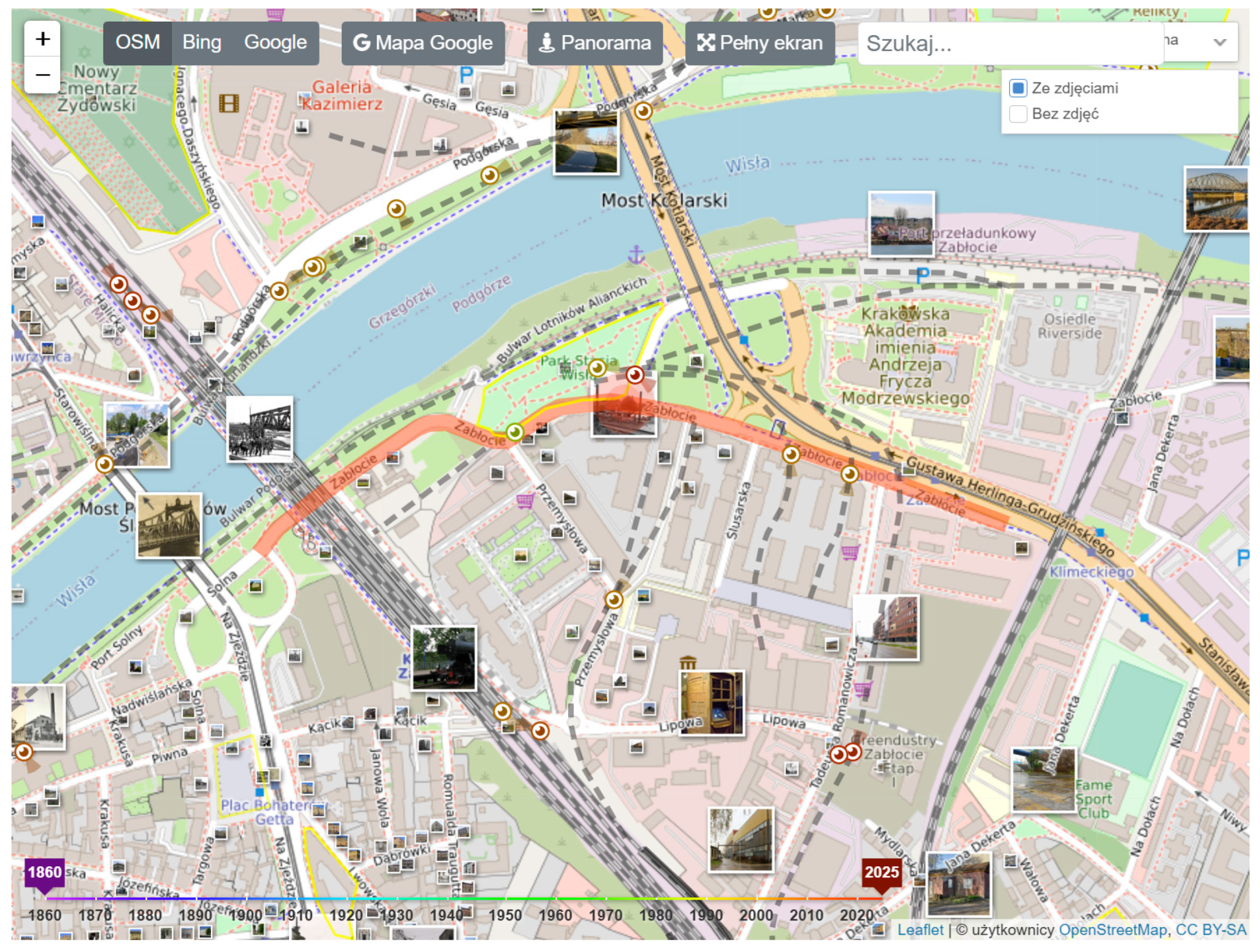
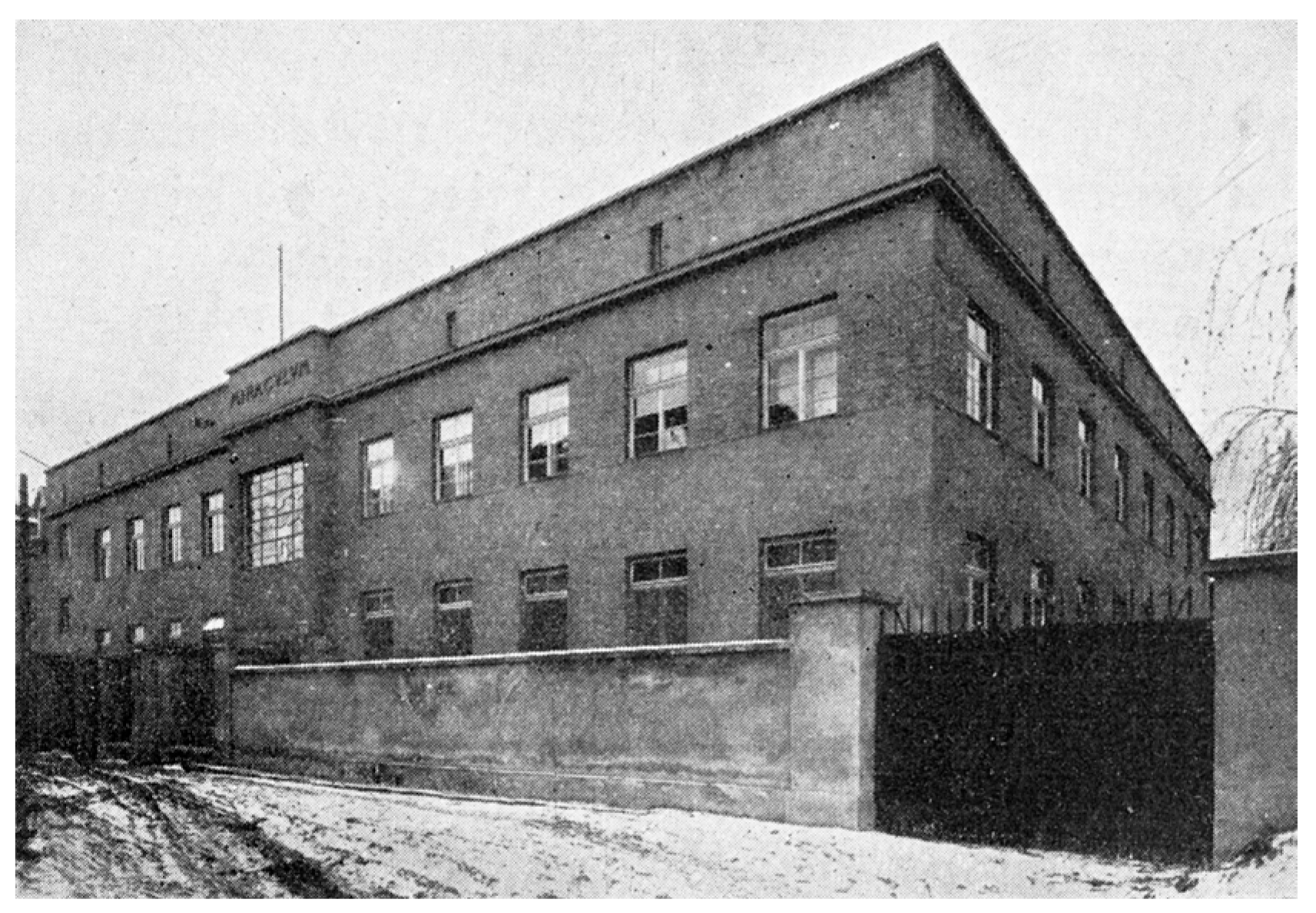
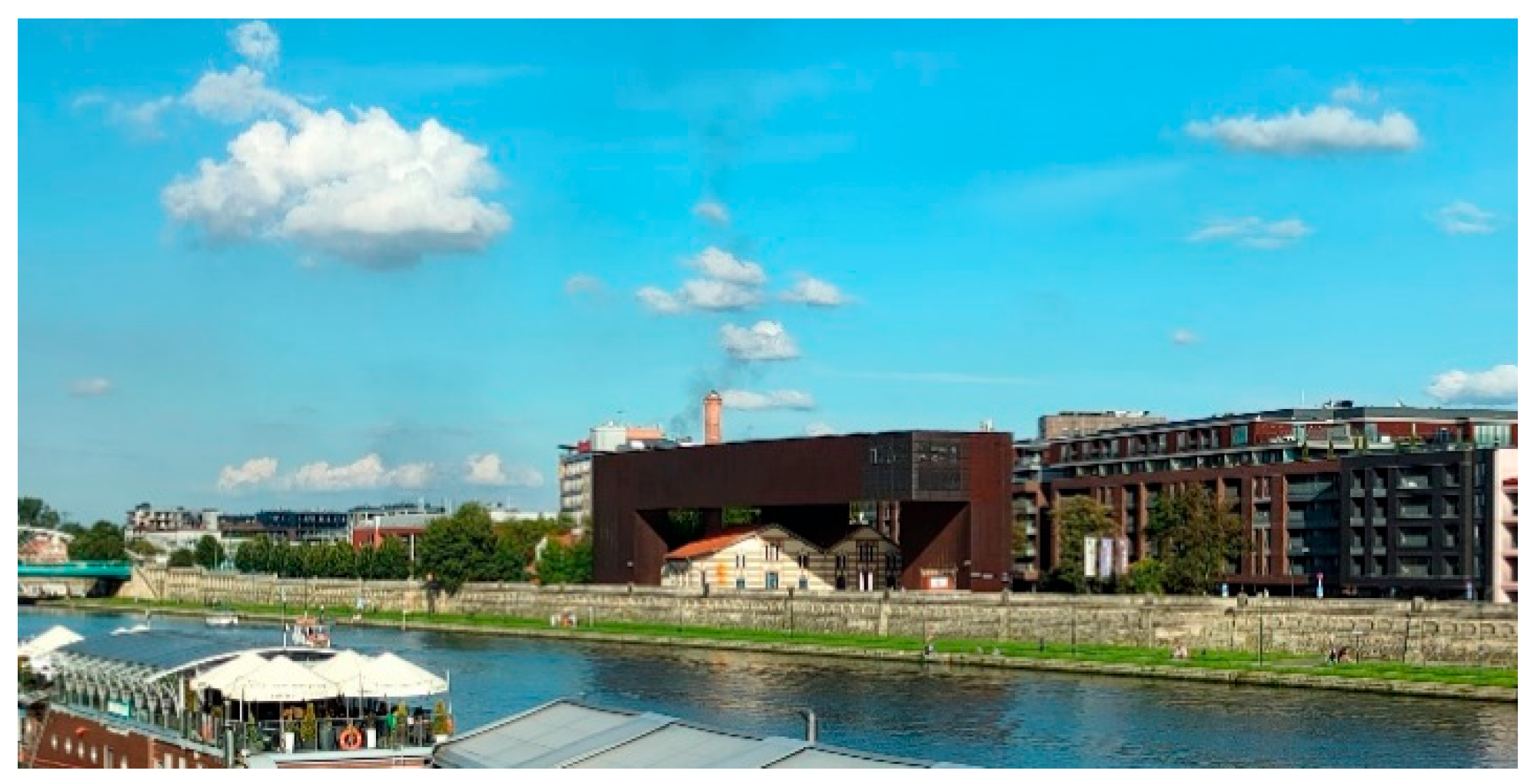



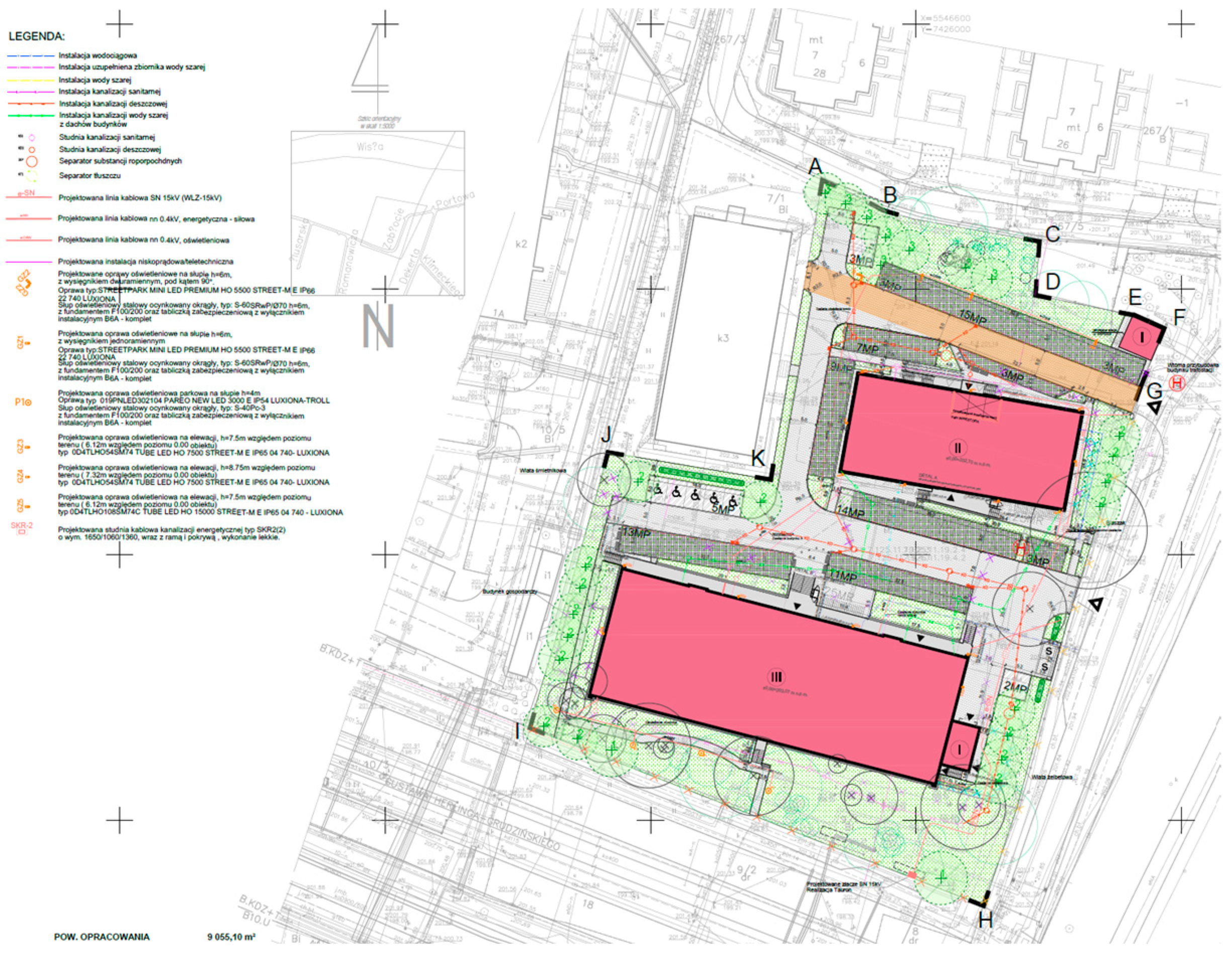

| Specific Objective | Description |
|---|---|
| Activation of civil society | The cluster is expected to engage residents and representatives of the non-governmental sector in civil society activities, contributing to the development of the local community. |
| Increase access to advanced social services | Through consulting, training and educational activities, the cluster supports the development of residents’ key competencies, empowering them in the labor market and in social life. |
| Support for grassroots initiatives | The initiative supports and animates the activity of residents, enabling the implementation of their ideas and strengthening cooperation at the local level. |
| Capacity development of community organizations | The cluster aims to strengthen NGOs, offering them support in developing their activities and building sustainable structures. |
| Reduction of social exclusion | The cluster’s activities focus on reducing the level of social exclusion and improving social cohesion in Kraków. |
| Networking and experience sharing | By building cooperative ties, the cluster creates space for the exchange of knowledge and the joint search for innovative solutions. |
| Support for entrepreneurship and start-ups | The cluster offers support for businesses in the early stages of development, especially among young, educated people, and promotes the creation of new jobs. |
| Promoting social entrepreneurship | As part of the cluster’s activities, it is planned to promote the economization of the non-governmental sector through the development of non-governmental organizations doing business. |
| Strengthening cooperation with the research and development (R&D) sector | One of the goals of the cluster is to strengthen cooperation between businesses and research and development units to foster innovation. |
| Development of the business environment | Creating a friendly environment for startups, freelancers, and microenterprises is part of the cluster’s long-term activities. |
| Functionality | Description |
|---|---|
| Project documentation management | The platform enables the central collection, review, and updating of design documentation, which minimizes the risk of working on outdated versions of documents. In the case of the Zabłocie Cluster, design documentation, including plans for the reconstruction of warehouse buildings, was available to all stakeholders in real time, which improved cooperation between the design and executive teams. |
| Building Information Modeling (BIM) | Integrating BIM technology with the CDE platform allowed for detailed planning and coordination of works. In the case of this investment, the modeling of construction and installation elements (especially due to the implementation system) was crucial, such as the introduction of new technical installations or a new communication system, which made it possible to avoid collisions and errors in implementation. |
| Communication and team integration | The platform has built-in chats and/or reporting modules, which allow for ongoing problem solving and the integration of design and implementation teams. |
| Quality management and control of construction documentation | Quality management modules allowed for entering data on implementation in accordance with design assumptions, as well as reporting defects and their repairs. Thanks to this, the implementation team could continuously monitor the quality of execution of individual elements. |
| Mobile access and site inspections | Dalux offers a mobile application that allows access to design data directly from the construction site. This functionality was particularly useful during construction inspections and real-time progress reporting. Thanks to the ability to mark comments on 3D models and send photos and comments directly from the field, the reporting and communication process between contractors and the investor was significantly improved. |
| Advantages | Disadvantages |
|---|---|
| Data centralization and transparency All project data were available in one place, which increased the transparency of the construction process and reduced the risk of errors resulting from working with outdated data. | Implementation costs Using the CDE platform involves additional costs that can be significant for smaller projects. |
| Process optimization and time savings By automating many processes, such as updating documentation or assigning tasks, the time spent on administration and coordination has been significantly reduced. | Need for staff training The implementation of modern technologies required training the team, which could initially affect the pace of work. |
| Improved quality of workmanship Quality control functions and the ability to report defects in real time have contributed to raising the standards of investment execution. | Data Security Storing data in the cloud requires ensuring adequate security against potential cyberattacks, which is always a concern for stakeholders. |
| Increased communication efficiency Built-in communication tools allowed for faster problem solving and better cooperation between all participants in the construction process. | |
| Financial savings Early detection of clashes in the BIM model and minimization of errors resulted in a reduction in costs related to corrections on the construction site. |
Disclaimer/Publisher’s Note: The statements, opinions and data contained in all publications are solely those of the individual author(s) and contributor(s) and not of MDPI and/or the editor(s). MDPI and/or the editor(s) disclaim responsibility for any injury to people or property resulting from any ideas, methods, instructions or products referred to in the content. |
© 2025 by the authors. Licensee MDPI, Basel, Switzerland. This article is an open access article distributed under the terms and conditions of the Creative Commons Attribution (CC BY) license (https://creativecommons.org/licenses/by/4.0/).
Share and Cite
Radziejowska, A.; Linczowski, K. Revitalization of Zabłocie in Kraków: Innovation Cluster as One of the Elements of District Development. Sustainability 2025, 17, 4651. https://doi.org/10.3390/su17104651
Radziejowska A, Linczowski K. Revitalization of Zabłocie in Kraków: Innovation Cluster as One of the Elements of District Development. Sustainability. 2025; 17(10):4651. https://doi.org/10.3390/su17104651
Chicago/Turabian StyleRadziejowska, Aleksandra, and Kazimierz Linczowski. 2025. "Revitalization of Zabłocie in Kraków: Innovation Cluster as One of the Elements of District Development" Sustainability 17, no. 10: 4651. https://doi.org/10.3390/su17104651
APA StyleRadziejowska, A., & Linczowski, K. (2025). Revitalization of Zabłocie in Kraków: Innovation Cluster as One of the Elements of District Development. Sustainability, 17(10), 4651. https://doi.org/10.3390/su17104651









